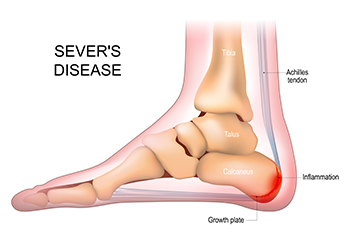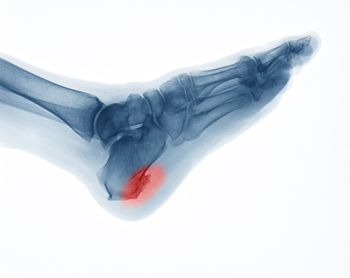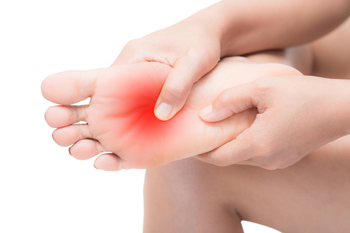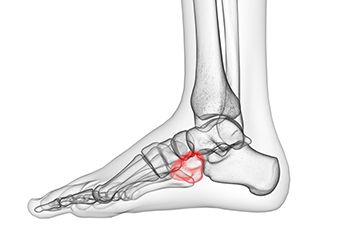Items filtered by date: November 2023
Recognizing Symptoms of Sever’s Disease

Sever's disease, despite its name, is not an illness but a common heel condition affecting growing children, particularly those engaged in sports or activities that involve repetitive stress on the heel bone. Commonly observed in children aged 8 to 14, Sever's disease arises from the inflammation of the growth plate in the heel, where the Achilles tendon attaches. Recognizing the symptoms is vital for early intervention. Affected children may experience heel pain, swelling, and tenderness, especially during or after physical activity. As bones grow faster than muscles and tendons during this age range, the tightness and strain on the heel's growth plate become more pronounced. Factors such as rapid growth, high-impact sports, or wearing inadequate footwear contribute to vulnerability. Understanding Sever's disease and its symptoms equips parents, coaches, and young athletes to navigate this temporary, but uncomfortable condition with informed care and appropriate preventive measures. If your active child has heel pain, it is strongly suggested that he or she is under the care of a podiatrist who can effectively diagnose and treat this condition.
Sever's disease often occurs in children and teens. If your child is experiencing foot or ankle pain, see Dr. Joshua David Scoll from Pennsylvania. Our doctor can treat your child’s foot and ankle needs.
Sever’s Disease
Sever’s disease is also known as calcaneal apophysitis, which is a medical condition that causes heel pain I none or both feet. The disease is known to affect children between the ages of 8 and 14.
Sever’s disease occurs when part of the child’s heel known as the growth plate (calcaneal epiphysis) is attached to the Achilles tendon. This area can suffer injury when the muscles and tendons of the growing foot do not keep pace with bone growth. Therefore, the constant pain which one experiences at the back of the heel will make the child unable to put any weight on the heel. The child is then forced to walk on their toes.
Symptoms
Acute pain – Pain associated with Sever’s disease is usually felt in the heel when the child engages in physical activity such as walking, jumping and or running.
Highly active – Children who are very active are among the most susceptible in experiencing Sever’s disease, because of the stress and tension placed on their feet.
If you have any questions, please feel free to contact one of our offices located in Philadelphia, Bensalem, and Fairless Hills, PA . We offer the newest diagnostic and treatment technologies for all your foot and ankle injuries.
Causes of Heel Spurs

Heel bone spurs, or calcaneal spurs, are abnormal bone growths that look like hard lumps on the back of or underneath the heel. These formations are caused by persistent irritation or stress on the heel bone. This prompts the cells responsible for bone growth to produce excess calcium deposits over time. One of the causes of heel spurs is tightness in soft tissues like ligaments, muscles, and tendons. When these tissues are under increased tension, they exert excessive force on the attached bone, leading to inflammation and the development of bone spurs. Conditions such as plantar fasciitis, characterized by heightened tension in the plantar fascia under the sole of the foot, can also be a factor. Wearing shoes that are too tight, lack support, or have an improper shape create repetitive friction on different foot areas. The back of the heel is particularly susceptible to this friction, resulting in the accumulation of calcium deposits and the subsequent formation of calcaneal bone spurs. Women, who frequently wear tight fitting shoes that have high heels or pointed toes, are at a higher risk of developing such heel bone spurs. If you believe you may have developed a heel bone spur, it is suggested that you make an appointment with a podiatrist for a comprehensive evaluation.
Heel spurs can be incredibly painful and sometimes may make you unable to participate in physical activities. To get medical care for your heel spurs, contact Dr. Joshua David Scoll from Pennsylvania. Our doctor will do everything possible to treat your condition.
Heels Spurs
Heel spurs are formed by calcium deposits on the back of the foot where the heel is. This can also be caused by small fragments of bone breaking off one section of the foot, attaching onto the back of the foot. Heel spurs can also be bone growth on the back of the foot and may grow in the direction of the arch of the foot.
Older individuals usually suffer from heel spurs and pain sometimes intensifies with age. One of the main condition's spurs are related to is plantar fasciitis.
Pain
The pain associated with spurs is often because of weight placed on the feet. When someone is walking, their entire weight is concentrated on the feet. Bone spurs then have the tendency to affect other bones and tissues around the foot. As the pain continues, the feet will become tender and sensitive over time.
Treatments
There are many ways to treat heel spurs. If one is suffering from heel spurs in conjunction with pain, there are several methods for healing. Medication, surgery, and herbal care are some options.
If you have any questions feel free to contact one of our offices located in Philadelphia, Bensalem, and Fairless Hills, PA . We offer the latest in diagnostic and treatment technology to meet your needs.
Causes of Nerve Pain in the Feet

When too much pressure is applied to a nerve in the foot, it can lead to a pinched nerve. This disrupts the nerve's normal function and causes a range of symptoms, including weakness, numbness, tingling sensations, and pain. Tarsal tunnel syndrome is a common condition that can result in a pinched nerve in the foot. The tarsal tunnel is a narrow passage in the ankle through which the tibial nerve runs, providing sensation to the bottom of the foot. When this nerve becomes compressed, it leads to tarsal tunnel syndrome and may cause a pinched nerve in the foot. Morton's neuroma is another condition that can lead to a pinched nerve in the foot. This condition involves the growth of a benign tumor on a nerve, often occurring between the third and fourth toes, just before the arch. Morton's neuroma results from the thickening of nerve tissue leading to the toes. It results in pain radiating from the ball of the foot to the ankle or toes and can cause numbness, cramping, or tingling sensations. People with Morton’s neuroma may feel a sensation of standing on a fold in a sock or having a pebble in the shoe. If you experience symptoms such as numbness, tingling, pain, or discomfort in your feet, it is suggested that you make an appointment with a podiatrist for an exam and a diagnosis.
Neuropathy
Neuropathy can be a potentially serious condition, especially if it is left undiagnosed. If you have any concerns that you may be experiencing nerve loss in your feet, consult with Dr. Joshua David Scoll from Pennsylvania. Our doctor will assess your condition and provide you with quality foot and ankle treatment for neuropathy.
What Is Neuropathy?
Neuropathy is a condition that leads to damage to the nerves in the body. Peripheral neuropathy, or neuropathy that affects your peripheral nervous system, usually occurs in the feet. Neuropathy can be triggered by a number of different causes. Such causes include diabetes, infections, cancers, disorders, and toxic substances.
Symptoms of Neuropathy Include:
- Numbness
- Sensation loss
- Prickling and tingling sensations
- Throbbing, freezing, burning pains
- Muscle weakness
Those with diabetes are at serious risk due to being unable to feel an ulcer on their feet. Diabetics usually also suffer from poor blood circulation. This can lead to the wound not healing, infections occurring, and the limb may have to be amputated.
Treatment
To treat neuropathy in the foot, podiatrists will first diagnose the cause of the neuropathy. Figuring out the underlying cause of the neuropathy will allow the podiatrist to prescribe the best treatment, whether it be caused by diabetes, toxic substance exposure, infection, etc. If the nerve has not died, then it’s possible that sensation may be able to return to the foot.
Pain medication may be issued for pain. Electrical nerve stimulation can be used to stimulate nerves. If the neuropathy is caused from pressure on the nerves, then surgery may be necessary.
If you have any questions, please feel free to contact one of our offices located in Philadelphia, Bensalem, and Fairless Hills, PA . We offer the newest diagnostic and treatment technologies for all your foot care needs.
Plantar Warts Can Be Treated!
Difficult Identification of Cuboid Syndrome

Cuboid syndrome has numerous alternate names, such as cuboid fault syndrome or lateral plantar neuritis. It manifests primarily as pain on the foot's outer edge, which stems from a misalignment of the cuboid bone. Located centrally within the foot, this bone connects seamlessly with other bones and is anchored by ligaments and tendons. A crucial joint in this context is the calcaneocuboid joint, vital for foot stability and motion. Problems arise when the bone displaces from its position, resulting in symptoms like pain, restricted motion, and challenges in weight-bearing. The diagnosis of cuboid syndrome often remains elusive as other issues can lead to lateral foot pain, such as gout, compression neuropathy, and tendinopathy. If cuboid syndrome is the culprit, treatment typically focuses on bone manipulation, with persistent cases demanding further interventions. If you have lateral foot pain, it is suggested that you make an appointment with a podiatrist for an examination, diagnosis, and treatment for its cause.
Cuboid syndrome, also known as cuboid subluxation, occurs when the joints and ligaments near the cuboid bone in the foot become torn. If you have cuboid syndrome, consult with Dr. Joshua David Scoll from Pennsylvania. Our doctor will assess your condition and provide you with quality foot and ankle treatment.
Cuboid syndrome is a common cause of lateral foot pain, which is pain on the outside of the foot. The condition may happen suddenly due to an ankle sprain, or it may develop slowly overtime from repetitive tension through the bone and surrounding structures.
Causes
The most common causes of cuboid syndrome include:
- Injury – The most common cause of this ailment is an ankle sprain.
- Repetitive Strain – Tension placed through the peroneus longus muscle from repetitive activities such as jumping and running may cause excessive traction on the bone causing it to sublux.
- Altered Foot Biomechanics – Most people suffering from cuboid subluxation have flat feet.
Symptoms
A common symptom of cuboid syndrome is pain along the outside of the foot which can be felt in the ankle and toes. This pain may create walking difficulties and may cause those with the condition to walk with a limp.
Diagnosis
Diagnosis of cuboid syndrome is often difficult, and it is often misdiagnosed. X-rays, MRIs and CT scans often fail to properly show the cuboid subluxation. Although there isn’t a specific test used to diagnose cuboid syndrome, your podiatrist will usually check if pain is felt while pressing firmly on the cuboid bone of your foot.
Treatment
Just as the range of causes varies widely, so do treatments. Some more common treatments are ice therapy, rest, exercise, taping, and orthotics.
If you have any questions, please feel free to contact one of our offices located in Philadelphia, Bensalem, and Fairless Hills, PA . We offer the newest diagnostic and treatment technologies for all your foot care needs.

